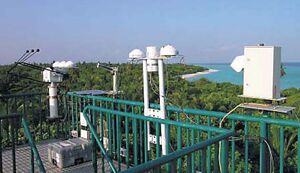Tom Sponheim (talk | contribs) |
(→Contact: Cat change) |
||
| Line 34: | Line 34: | ||
[[Category:Individuals|Ramanathan]] |
[[Category:Individuals|Ramanathan]] |
||
[[Category:India|Ramanathan]] |
[[Category:India|Ramanathan]] |
||
| − | [[Category:Solar Cookers |
+ | [[Category:Solar Cookers International Network members|Ramanathan]] |
Revision as of 05:08, 15 June 2013
News and recent developments
- March 2008: A March 2007 white paper — by Dr. Veerabhadran Ramanathan, distinguished professor of climate and atmospheric sciences at the Scripps Institution of Oceanography, University of California, San Diego (USA), and Dr. Kalpana Balakrishnan, head of the Environmental Health Engineering department at Sri Ramachandra University, Chennai, India — outlines a project to reduce air pollution and global warming with community-wide use of solar cookers and improved biofuel cooking devices. The authors provide many referenced details about the negative health and environmental impacts of biomass burning and biofuel cooking, which they say are “the major sources of elemental carbon (EC) in India and other developing nations.” Carbon dioxide and EC, or soot, are the “two largest agents of global warming.” In India, where a reported 90 percent of cooking is done over wood- and dung-fueled fires, several studies have documented that “indoor air pollution leads to 400,000-550,000 premature deaths … from lower respiratory infections and chronic obstructive pulmonary disease. … The burden falls disproportionately on women and children, who inhale soot and other particles from smoke released by the burning of biofuels.” This soot combines with outdoor air pollution to form atmospheric brown clouds (ABCs) that “envelope most of India and the Indian Ocean … [leading] to a large reduction of sunlight at the ground and … atmospheric solar heating.” Since EC and other particles in ABCs have relatively short lifetimes compared to carbon dioxide in the atmosphere, the authors believe global EC reductions can “give us a decade or two to come up with viable and sustainable alternatives for fossil fuel combustion.” In the proposed “Project Surya,” solar cookers will be distributed in 65 villages in the Periyar PURA region in the Thanjavur and Pudukkottai districts of Tamil Nadu, benefiting approximately 6,500 households that currently use about 5 kilograms of firewood per day. Other fuel-efficient cooking devices will be available for use at night or on inclement days. The region has a strong base of local nongovernmental organizations and social networks, including women’s self-help groups, that will be useful for project implementation. Input and feedback from the communities will be gathered and used in a number of ways. Surveys of eating habits and estimated cooking fuel requirements will be conducted. Meetings with local leaders will be used to demonstrate a range of solar cooking technologies and to solicit feedback on their suitability and probability of acceptance in the communities at large. Educational outreach and incentives will be used to maximize use of clean cooking technologies. Installation, operation and maintenance training programs will be offered for those interested. Data collection will begin six months before the project launch, and will continue for at least a year after. Using special instrument towers, researchers will measure concentrations of particulates and soot content, as well as surface solar radiation. If feasible, indoor air pollution will be monitored using special equipment installed in select homes. (Alternatively, a mobile laboratory may be used.) Children will be involved as well, collecting data on cooking fuel use and cooking times, among other things. This data will help quantify the reduction in biofuel use and soot emissions. Though the authors state “it is difficult and costly to [accurately] quantify the disease burden due to indoor air pollution,” they “propose to build the evidence for expected health improvements … through documentation of exposure reduction and subsequently through reduction in incidence and severity of diseases.” The stated goals of the project, in order of importance, are: 1. To eliminate the detrimental health effects of indoor smoke; 2. To reduce the negative effects of EC in ABCs on the summer monsoon rainfall, Himalyan glacier retreat and agriculture; 3. To mitigate the global warming effects of CO2 and elemental carbon. Contact: Vanessa A. Balta Cook, Center for Clouds, Chemistry and Climate at SIO-UCSD. Tel: 858-534-8815, Web: http://www-ramanathan.ucsd.edu/ProjectSurya.html
Articles in the media
- April 2006 Autonomous Unmanned Aerial Vehicles (AUAVs) Take to the Skies to Track Pollutants National Science Foundation
- February 2008 The Other Carbon: Reducing Black Carbon's Role in Global Warming Wired Science
- May 2008: Solar-cooker project could cut air pollution - San Diego Union Tribune
- August 2008 UAVs Search For Scientific Silver Lining in Beijing Pollution Clouds Wired Science
See Also
External links
Contact
Mailing Address:
Prof. V. Ramanathan
Center for Clouds, Chemistry and Climate (C4)
Scripps Institution of Oceanography (SIO)
University of California, San Diego (UCSD)
9500 Gilman Drive, MC 0221
La Jolla, CA 92093-0221
Phone: (858) 534-8815
Fax: (858) 822-5607

